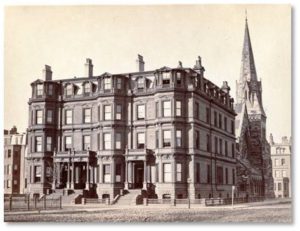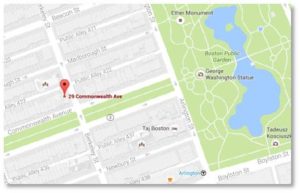The developers currently building a slew of tall, thin residential buildings in several of Boston’s neighborhoods can look to a historical model of how it looks when a building is too tall, too thin, too narrow and thus out of proportion to the rest of its surroundings: Haddon Hall in the Back Bay.
Unmistakable, especially in the winter when branches are bare, Haddon Hall stands far above any other building in the area except for church steeples. Although less obtrusive in the summer, Haddon Hall still resembles the proverbial sore thumb, sticking out of an architecturally homogeneous and cohesive environment.
That doesn’t mean it’s an ugly building; it’s just out of place Designed by architect J. Pickering Putnam, it offered Boston’s residents Paris-style, floor-through flats—26 suites of three or four rooms each. The concept made Haddon Hall very different from the fashionable home of the time, the four-story townhouse that dominates the South End and the Back Bay.
These houses, typically 25 feet wide, provided a vertical life style. Residents swept up elaborate staircases carved from marble and rare woods. Servants, less fortunate, ran up and down the utilitarian back stairs carrying heavy tea trays, coal scuttles, soup tureens, buckets and mops, freshly ironed clothing, packages and other burdens. How the women managed this wearing dresses with long, voluminous skirts without tripping and falling mystifies me.
Haddon Hall: The Site

29-30-31 Commonwealth Avenue
(ca. 1870), photograph by Frederick M. Smith, II; courtesy of the Print Department, Boston Public Library
The first problem with Haddon Hall came from its site. It replaced one of three contiguous townhouses (29-30-31 Commonwealth Ave.) that were built around 1864 on Boston’s “new land,” the Back Bay. They, in turn, were part of a row of 10 townhouses of the same design constructed from 1863 to 1873.
The three homes, designed by Gridley J. Fox Bryant and Arthur T. Gilman, stood as a cohesive block until 1892, when William Henry Harrison Newman bought No. 29 at auction from the estate of Elizabeth Bowditch.
Mr. Newman intended to build a “handsome new apartment hotel” on the site with “all the modern conveniences.” The architect he chose was considered a pioneer in the concept of the modern apartment building, with a special interest in plumbing and ventilation. He even wrote a book on “Plumbing and Household Sanitation” and earned a number of related design patents, including a design for a washbasin.The site had a 22-foot frontage on Commonwealth Avenue but stretched 104-feet deep on Berkley Street. That made it long and narrow.
Haddon Hall: The Height
Mr. Putnam knew that consistency was one of the three goals the Commissioners of Public Lands wanted to achieve in the Back Bay, along with spaciousness and the creation of an ornament to the city. The regulations, drawn up in 1857, dictated that that homes were to be built, “of a minimum height, constructed of masonry, and could not project beyond the standard building line.”
At the time deed restrictions mandated only a minimum height restriction of three stories in the Back Bay to ensure that no temporary structures were built and to maintain a uniform cornice line that reinforced the neighborhood’s “look and feel.” The deed restrictions were written in 1857, when a maximum height was considered unnecessary. Before the use of elevators in public buildings, five stories marked the height that people were expected to climb. In commercial buildings, the managing partners usually placed their offices on the second floor while junior employees had to hoof it all the way to the top.
Haddon Hall: Changing the Rules
Haddon Hall changed the rules. Mr. Putnam designed a building that was not only taller than any other Back Bay structure outside of a church, he made it of yellow-tan brick and brownstone. This gave it an appearance very different from the predominant red brick and sandstone preferred by the commissioners. He also demarcated each floor with brown string courses that ripple over the bays on the building’s Commonwealth Avenue end. This emphasizes the stack of individual floors and gives it a resemblance to a tall layer cake.
Mr. Putnam’s design created “nine generous stories” that are now listed as 11. That doesn’t sound outrageous in today’s environment where residential towers rise to 56 stories and up, but Haddon Hall looks much bigger simply because it is out of proportion to the buildings around it, including the two contiguous homes. Not only does it break the cornice line, it ruptures it. The disproportion is made more striking by the fact that No. 30 and No. 31 still exist in their original form. It appears like a skyscraper shooting up from a neighborhood of private homes.
Boston: The Outrage
Perhaps if Haddon Hall had led to a new and taller pattern of development like that which created the boulevards of Paris it would eventually have fit in with the later structures. Outraged, however, the people of Boston demanded change to ensure that such a monstrosity never rose again. (This is a rare example of Bostonians demanding change to maintain the status quo.)
They mobilized under the auspices of the Twentieth Century club, an organization that promoted progressive causes. In 1896 the club members submitted a bill to the legislature that set 80 feet as the maximum height for a building outside of what was termed the “high building district,” where it remained at 125 feet. This deed restriction was later reduced to 65 feet.
Haddon Hall opened in the midst of a depression and was not immediately profitable. It was converted from apartments to business and professional suites in 1928, and was once dubbed “the dentists’ building.”
Information and Directions
 Haddon Hall is a private building so you can’t go in but you can see it well from the corner of Commonwealth Avenue and Berkley Street or from the Commonwealth Avenue Mall. You can park in the Boston Common garage and walk through the Public Garden.Or take the T’s Green Line to the the Arlington Street station and walk north along Arlington Street. Follow the Commonwealth Avenue Mall until you come to Berkeley Street. Haddon Hall is on the northwest corner. You can’t miss it.
Haddon Hall is a private building so you can’t go in but you can see it well from the corner of Commonwealth Avenue and Berkley Street or from the Commonwealth Avenue Mall. You can park in the Boston Common garage and walk through the Public Garden.Or take the T’s Green Line to the the Arlington Street station and walk north along Arlington Street. Follow the Commonwealth Avenue Mall until you come to Berkeley Street. Haddon Hall is on the northwest corner. You can’t miss it.


